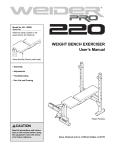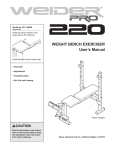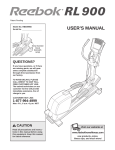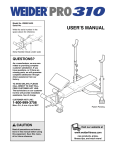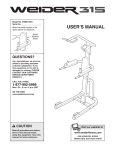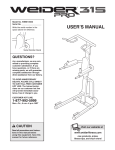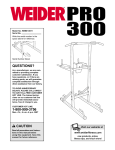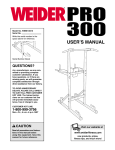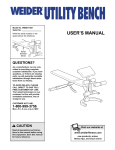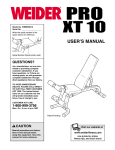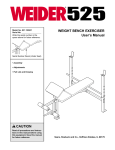Download Weider PRO 220 WEIGHT BENCH EXERCISER 15029 User's Manual
Transcript
Model No. 831.150292 Serial No. Write the serial number in the space above for reference. WEIGHT BENCH EXERCISER User’s Manual Serial Number Decal (under seat) • Assembly • Adjustments • Troubleshooting • Part List and Drawing Patent Pending CAUTION Read all precautions and instructions in this manual before using this equipment. Save this manual for future reference. Sears, Roebuck and Co., Hoffman Estates, IL 60179 TABLE OF CONTENTS WARNING DECAL PLACEMENT . . . . . . . . . . . . . . . . . . . . . . . . . . . . . . . . . . . . . . . . . . . . . . . . . . . . . . . . . . . . . .2 IMPORTANT PRECAUTIONS . . . . . . . . . . . . . . . . . . . . . . . . . . . . . . . . . . . . . . . . . . . . . . . . . . . . . . . . . . . . . . . . .3 BEFORE YOU BEGIN . . . . . . . . . . . . . . . . . . . . . . . . . . . . . . . . . . . . . . . . . . . . . . . . . . . . . . . . . . . . . . . . . . . . . . .4 ASSEMBLY . . . . . . . . . . . . . . . . . . . . . . . . . . . . . . . . . . . . . . . . . . . . . . . . . . . . . . . . . . . . . . . . . . . . . . . . . . . . . . .5 ADJUSTMENTS . . . . . . . . . . . . . . . . . . . . . . . . . . . . . . . . . . . . . . . . . . . . . . . . . . . . . . . . . . . . . . . . . . . . . . . . . . .9 EXERCISE GUIDELINES . . . . . . . . . . . . . . . . . . . . . . . . . . . . . . . . . . . . . . . . . . . . . . . . . . . . . . . . . . . . . . . . . . .10 ORDERING REPLACEMENT PARTS . . . . . . . . . . . . . . . . . . . . . . . . . . . . . . . . . . . . . . . . . . . . . . . . . .Back Cover FULL 90-DAY WARRANTY . . . . . . . . . . . . . . . . . . . . . . . . . . . . . . . . . . . . . . . . . . . . . . . . . . . . . . . . . . .Back Cover WARNING DECAL PLACEMENT The warning decals shown here have been placed on the weight bench in the locations shown. If a decal is missing or illegible, please call toll-free 1-877-992-5999, Mon. through Fri., 6 a.m. until 6 p.m. Mountain Time, to order a free replacement decal. Place the decal on the weight bench in the location shown. Keep hands and fingers clear of this area. 2 IMPORTANT PRECAUTIONS WARNING: To reduce the risk of serious injury, read the following important precautions before using the weight bench. 1. Read all instructions in this manual before using the weight bench. Use the weight bench only as described in this manual. 10. Keep hands and feet away from moving parts. 11. The weight bench is designed to support a maximum user weight of 300 pounds, and a maximum total weight of 410 pounds. Do not place more than 110 pounds, including a barbell and weights, on the weight rests. Do not place more than 50 pounds on the leg lever. 2. It is the responsibility of the owner to ensure that all users of the weight bench are adequately informed of all precautions. 3. The weight bench is intended for home use only. Do not use the weight bench in any commercial, rental, or institutional setting. 12. Always make sure there is an equal amount of weight on each side of your barbell when you are using it. Always keep some weight on both ends of the barbell when adding or removing weights to prevent the barbell from tipping. 4. Keep the weight bench indoors, away from moisture and dust. Do not put the weight bench in a garage or covered patio, or near water. 13. When you are using the leg lever, place a barbell with the same amount of weight on the weight rests to balance the bench. 5. Use the weight bench only on a level surface. Cover the floor beneath the weight bench to protect the floor. 14. Always exercise with a partner. When you are performing bench press exercises, your partner should stand behind you to catch the barbell if you cannot complete a repetition. 6. Make sure all parts are properly tightened each time the weight bench is used. Replace any worn parts immediately. 8. Always wear athletic shoes for foot protection while exercising. 15. When using the backrest in an inclined position, make sure that the support rod is inserted completely through both uprights, and that the support rod is turned to the locked position. 9. Do not use a barbell that is longer than six feet with the weight bench. Note: The weight bench does not include a barbell or weights. 16. If you feel pain or dizziness at any time while exercising, stop immediately and begin cooling down. 7. Keep children under 12 and pets away from the weight bench at all times. WARNING: Before beginning this or any exercise program, consult your physician. This is especially important for persons over the age of 35 or persons with pre-existing health problems. Read all instructions before using. Sears assumes no responsibility for personal injury or property damage sustained by or through the use of this product. 3 BEFORE YOU BEGIN reading this manual, call 1-800-4-MY-HOME® (1-800-469-4663). To help us assist you, please note the product model number and serial number before calling. The model number is 831.150292. The serial number can be found on a decal attached to the weight bench (see the front cover of this manual for the location of the decal). Thank you for selecting the versatile WEIDER® PRO 220 weight bench. The weight bench offers an impressive array of weight stations designed to develop every major muscle group of the body. Whether your goal is to tone your body, build dramatic muscle size and strength, or improve your cardiovascular system, the weight bench will help you to achieve the specific results you want. Before reading further, please review the drawing below and familiarize yourself with the parts that are labeled. For your benefit, read this manual carefully before using the weight bench. If you have questions after ASSEMBLED DIMENSIONS: Height: 47 in. Width: 30 in. Depth: 62 in. Weight Rests Upright Backrest Support Rod Seat Leg Lever Weight Tube 4 ASSEMBLY • As you assemble the weight bench, make sure all parts are oriented as shown in the drawings. Make Things Easier for Yourself Everything in this manual is designed to ensure that the weight bench can be assembled successfully by anyone. However, it is important to realize that the versatile weight bench has many parts and that the assembly process will take time. Most people find that by setting aside plenty of time, assembly will go smoothly. • For help identifying small parts, use the PART IDENTIFICATION CHART. The following tools (not included) are required for assembly: • Two adjustable wrenches • One rubber mallet Before beginning assembly, carefully read the following information and instructions: • One standard screwdriver • Assembly requires two people. • One Phillips screwdriver • Place all parts in a cleared area and remove the packing materials. Do not dispose of the packing materials until assembly is completed. • Lubricant, such as grease or petroleum jelly, and soapy water. Assembly will be more convenient if you have a socket set, a set of open-end or closed-end wrenches, or a set of ratchet wrenches. • Tighten all parts as you assemble them, unless instructed to do otherwise. 1. Before assembling the weight bench, be sure that you have read and understand the information in the box above. 1 Attach two Joint Plates (11) to the Upright (1) without the warning decal with two M10 x 66mm Bolts (28) and two M10 Nylon Locknuts (31). Do not tighten the Locknuts yet. 1 Warning Decal Repeat this step with the other Upright (1). Make sure the Joint Plates (11) are oriented as shown in the inset drawing. 11 31 11 28 1 5 2. Attach the Crossbar (2) to an Upright (1) with two M10 x 66mm Bolts (28), two Joint Plates (11), and two M10 Nylon Locknuts (31). Do not tighten the Locknuts yet. 2 Repeat this step with the other Upright (1). 1 1 31 11 11 28 3. Attach the Front Leg (4) to the Bench Frame (3) with an M10 x 66mm Bolt (28), an M10 x 19mm Screw (5), an M10 Washers (30), and an M10 Nylon Locknut (31). Do not tighten the Locknut or Screw yet. 2 3 5 28 31 30 4. Attach the Bench Frame (3) to the Crossbar (2) with two M10 x 68mm Bolts (27) and two M10 Nylon Locknuts (31). 4 4 27 2 3 31 6 3 5. Insert the Support Rod (14) into a set of holes in the Uprights (1). Turn the Support Rod so the locking pin is wrapped around the Upright. 5 14 Tighten the M10 Nylon Locknuts (31) and M10 x 19mm Screw (5) used in steps 1–5. 1 Locking Pin 6. Lubricate the M10 x 60mm Bolt (25) with grease. Attach the Leg Lever (6) to the Front Leg (4) with the Bolt and an M10 Nylon Locknut (31). Do not overtighten the Locknut; the Leg Lever must be able to pivot easily. 6 31 25 4 6 Lubricate 7. Slide a Pad Tube (12) into the Leg Lever (6). Slide two Foam Pads (13) onto the ends of the Pad Tube. Make sure the Foam Pads are oriented as shown. 7 6 13 Repeat this step with the other Pad Tube (12). 12 13 12 8. Insert a Weight Rest (15) into an Upright (1). Turn the Weight Rest so the locking pin is wrapped around the Upright. 8 15 Repeat this step with the other Weight Rest (15). Locking Pin 1 15 7 9. Attach the Backrest Tubes (7) to the Backrest (8) with four M6 x 38mm Screws (32) and four M6 Washers (22). Do not tighten the Screws yet. Make sure that the name embroidery is in the indicated location. 9 8 Name Embroidery 22 7 22 32 32 10. Lubricate an M10 x 142mm Bolt (23) with grease. Attach the Backrest Tubes (7) to the welded tube on the Bench Frame (3) with the Bolt, two M10 Washers (30), and an M10 Nylon Locknut (31). Do not overtighten the Locknut; the Backrest Tubes must be able to pivot easily. 10 30 31 Tighten the M6 x 38mm Screws (32) used in step 10. 7 3 30 23 Lubricate Tube 11. Attach the Seat (9) to the Bench Frame (3) with four M6 x 16mm Screws (24). Make sure the Seat is oriented as shown. 11 9 Rounded Edge 3 12. Make sure that all parts are properly tightened before you use the weight bench. The use of all remaining parts will be explained in ADJUSTMENTS, beginning on the following page. 24 8 24 ADJUSTMENTS The weight bench is designed to be used with your own weight set (not included). The steps below explain how the weight bench can be adjusted. See EXERCISE GUIDELINES on page 10 for important exercise information and refer to the accompanying exercise guide to see the correct form for each exercise. Refer also to the exercise information accompanying your weight set for additional exercises. Make sure all parts are properly tightened each time the weight bench is used. Replace any worn parts immediately. The weight bench can be cleaned with a damp cloth and a mild, non-abrasive detergent. Do not use solvents. ADJUSTING THE BACKREST 1 The Backrest (8) can be used in a decline position, a level position, or two incline positions. To use the Backrest in the decline position, remove the Support Rod (14) and lay the Backrest on the Crossbar (2). 1 To use the Backrest (8) in the level position, lift the Backrest and insert the Support Rod (14) through the bottom set of holes in the Uprights (1). Rotate the locking pin into place around the Upright. 8 14 To use the Backrest (8) in an incline position, lift the Backrest and insert the Support Rod (14) through an upper set of holes in the Uprights (1). Rotate the locking pin into place around the Upright. WARNING: When using the Backrest (8) in a level or incline position, insert the Support Rod (14) completely through both Uprights (1) and turn it to the locked position. 2 6 ATTACHING WEIGHTS TO THE LEG LEVER To use the Leg Lever (6), slide the desired weights (not included) onto the weight tube. Weight Tube WARNING: Do not place more than 50 pounds on the Leg Lever (6). Weight ADJUSTING THE WEIGHT RESTS To change the height of the Weight Rests (15), remove them from the Uprights (1) and insert them into the desired set of holes. Rotate the Weight Rests so that the locking pins wrap around the Uprights. 15 Locking Pin Locking Pin 15 1 WARNING: Always set both Weight Rests (15) at the same height. 1 9 EXERCISE GUIDELINES THE FOUR BASIC TYPES OF WORKOUTS PERSONALIZING YOUR EXERCISE PROGRAM Muscle Building To increase the size and strength of your muscles, push them close to their maximum capacity. Your muscles will continually adapt and grow as you progressively increase the intensity of your exercise. You can adjust the intensity level of an individual exercise in two ways: • by changing the amount of resistance used • by changing the number of repetitions or sets performed. (A “repetition” is one complete cycle of an exercise, such as one sit-up. A “set” is a series of repetitions.) Determining the exact length of time for each workout, as well as the number of repetitions or sets completed, is an individual matter. It is important to avoid overdoing it during the first few months of your exercise program. You should progress at your own pace and be sensitive to your body’s signals. If you experience pain or dizziness at any time while exercising, stop immediately and begin cooling down. Find out what is wrong before continuing. Remember that adequate rest and a proper diet are important factors in any exercise program. WARMING UP The proper amount of resistance for each exercise depends upon the individual user. You must gauge your limits and select the amount of resistance that is right for you. Begin with 3 sets of 8 repetitions for each exercise you perform. Rest for 3 minutes after each set. When you can complete 3 sets of 12 repetitions without difficulty, increase the amount of resistance. Begin each workout with 5 to 10 minutes of stretching and light exercise to warm up. Warming up prepares your body for more strenuous exercise by increasing circulation, raising your body temperature and delivering more oxygen to your muscles. WORKING OUT Toning You can tone your muscles by pushing them to a moderate percentage of their capacity. Select a moderate amount of resistance and increase the number of repetitions in each set. Complete as many sets of 15 to 20 repetitions as possible without discomfort. Rest for 1 minute after each set. Work your muscles by completing more sets rather than by using high amounts of resistance. Weight Loss To lose weight, use a low amount of resistance and increase the number of repetitions in each set. Exercise for 20 to 30 minutes, resting for a maximum of 30 seconds between sets. Cross Training Cross training is an efficient way to get a complete and well-balanced fitness program. An example of a balanced program is: • Plan strength training workouts on Monday, Wednesday, and Friday. • Plan 20 to 30 minutes of aerobic exercise, such as running on a treadmill or riding on an exercise bike, on Tuesday and Thursday. • Rest from both strength training and aerobic exercise for at least one full day each week to give your body time to regenerate. The combination of strength training and aerobic exercise will reshape and strengthen your body, plus develop your heart and lungs. Each workout should include 6 to 10 different exercises. Select exercises for every major muscle group, emphasizing areas that you want to develop most. To give balance and variety to your workouts, vary the exercises from session to session. Schedule your workouts for the time of day when your energy level is the highest. Each workout should be followed by at least one day of rest. Once you find the schedule that is right for you, stick with it. EXERCISE FORM Maintaining proper form is an essential part of an effective exercise program. This requires moving through the full range of motion for each exercise, and moving only the appropriate parts of the body. Exercising in an uncontrolled manner will leave you feeling exhausted. On the exercise guide accompanying this manual you will find photographs showing the correct form for several exercises, and a list of the muscles affected. Refer to the muscle chart on the next page to find the names of the muscles. The repetitions in each set should be performed smoothly and without pausing. The exertion stage of each repetition should last about half as long as the return stage. Proper breathing is important. Exhale during the exertion stage of each repetition and inhale during the return stroke. Never hold your breath. 10 slowly as you stretch and do not bounce. Ease into each stretch gradually and go only as far as you can without strain. Stretching at the end of each workout is an effective way to increase flexibility. Rest for a short period of time after each set. The ideal resting periods are: • Rest for three minutes after each set for a muscle building workout. • Rest for one minute after each set for a toning workout. • Rest for 30 seconds after each set for a weight loss workout. Plan to spend the first couple of weeks familiarizing yourself with the equipment and learning the proper form for each exercise. STAYING MOTIVATED For motivation, keep a record of each workout. List the date, the exercises performed, the resistance used, and the numbers of sets and repetitions completed. Record your weight and key body measurements at the end of every month. Remember, the key to achieving the greatest results is to make exercise a regular and enjoyable part of your everyday life. COOLING DOWN End each workout with 5 to 10 minutes of stretching. Include stretches for both your arms and legs. Move MUSCLE CHART O A P L B Q C R D S E T F G M U N H V I W J X K 11 A. B. C. D. E. F. G. H. I. J. K. L. M. N. O. P. Q. R. S. T. U. V. W. X. Sternomastoid (neck) Pectoralis Major (chest) Biceps (front of arm) Obliques (waist) Brachioradials (forearm) Hip Flexors (upper thigh) Abductor (outer thigh) Quadriceps (front of thigh) Sartorius (front of thigh) Tibialis Anterior (front of calf) Soleus (front of calf) Anterior Deltoid (shoulder) Rectus Abdominus (stomach) Adductor (inner thigh) Trapezius (upper back) Rhomboideus (upper back) Posterior Deltoid (shoulder) Triceps (back of arm) Latissimus Dorsi (mid back) Spinae Erectors (lower back) Gluteus Medius (hip) Gluteus Maximus (buttocks) Hamstring (back of leg) Gastrocnemius (back of calf) PART IDENTIFICATION CHART This chart is provided to help you identify the small parts used in assembly. The number in parenthesis below each part refers to the key number of the part, from the PART LIST. Important: Some parts may have been pre-assembled for shipping purposes. If you cannot find a part in the parts bags, check to see if it has been pre-assembled. If a part is missing, call toll-free 1-877-992-5999. M10 x 19mm Screw (5) M6 x 16mm Screw (24) M6 x 38mm Screw (32) M10 Nylon Locknut (31) M10 x 60mm Bolt (25) M6 Washer (22) M10 x 66mm Bolt (28) M10 Washer (30) M10 x 68mm Bolt (27) M10 x 142mm Bolt (23) PART LIST—Model No. 831.150292 Key No. Qty. 1 2 3 4 5 6 7 8 9 10 11 12 13 14 15 16 17 18 19 2 1 1 1 1 1 2 1 1 2 4 2 4 1 2 3 1 2 4 Description Upright Crossbar Bench Frame Front Leg M10 x 19mm Screw Leg Lever Backrest Tube Backrest Seat Upright Cover Joint Plate Pad Tube Foam Pad Support Rod Weight Rest 50mm Square Inner Cap 25mm Round Angled Cap 38mm Square Inner Cap 25mm Square Inner Cap R1104B Key No. Qty. 20 21 22 23 24 25 26 27 28 29 30 31 32 33 34 # # # 2 2 4 1 4 1 6 2 9 4 3 13 4 1 4 1 1 1 Description 25mm Round Inner Cap 21mm Round Inner Cap M6 Washer M10 x 142mm Bolt M6 x 16mm Screw M10 x 60mm Bolt 25mm x 50mm Inner Cap M10 x 68mm Bolt M10 x 66mm Bolt M4 x 16mm Screw M10 Washer M10 Nylon Locknut M6 x 38mm Screw 25mm Round (Thick) Inner Cap 19mm Square Inner Cap User’s Manual Exercise Guide Grease Pack “#” Indicates a non-illustrated part. Specifications are subject to change without notice. See the back cover of this manual for information on ordering replacement parts. EXPLODED DRAWING—Model No. 831.150292 R1104B 8 16 19 29 15 21 7 31 30 20 19 10 29 14 22 7 32 22 30 23 21 16 32 10 29 31 15 1 26 11 11 2 11 26 13 28 34 29 11 28 12 9 34 13 20 31 34 27 26 13 1 12 26 5 34 28 13 3 16 31 25 18 31 6 17 33 30 4 26 18 26 24 24 31 FULL 90-DAY WARRANTY For 90 days from the date of purchase, if failure occurs due to defect in material or workmanship in this WEIGHT BENCH EXERCISER, contact the nearest Sears Service Center throughout the United States and Sears will repair or replace the WEIGHT BENCH EXERCISER, free of charge. This warranty does not apply when the WEIGHT BENCH EXERCISER is used commercially or for rental purposes. This warranty gives you specific legal rights, and you may also have other rights which vary from state to state. Sears, Roebuck and Co., Dept. 817WA, Hoffman Estates, IL 60179 Part No. 221115 R1104B Printed in China © 2004 Sears, Roebuck and Co.















